HISTORY
KEY DATES FOR THE U.S. ARMY IN VIETNAM
The U.S. actions in Vietnam began slowly with the deployment of advisors in the early 1950s and expanded incrementally to include combat forces in July 1965. The conflict continued until January 1973, when representatives of the United States, North and South Vietnam, and the Vietcong signed a peace agreement in Paris. U.S. forces returned home over the next few months, with the last military unit leaving on March 29, 1973.
TIMELINE
- 1950 U.S. Advisors deployed to Vietnam 1950 - 1965. The U.S. actions in Vietnam began slowly with the deployment of advisors in the early 1950s and expanded incrementally to include the deployment of combat forces in July 1965.
- 1965 Operation Silver Bayonet Begins October 23, 1965. US troops together with South Vietnamese forces engage in combat operations with North Vietnamese forces in the Pleku Province in the Central Highlands.
- Battle of Ia Drang Valley Begins November 14, 1965. The Battle of Ia Drang was the first major battle between the United States Army and the People's Army of Vietnam, as part of the Pleiku Campaign conducted early in the Vietnam War, at the eastern foot of the Chu Pong Massif in the central highlands of Vietnam. Photo: Army Maj. Bruce Crandall's UH-1D Iroquois helicopter climbs skyward after discharging a load of infantrymen on a search-and-destroy mission in Vietnam. Click image to see video.
- 1967 Operation Cedar Falls Begins January 8, 1967. Operation Cedar Falls was the largest American ground operation of the Vietnam war: Two Army divisions, one infantry and one paratrooper brigade, and one armored cavalry regiment participated in the operation. Altogether, it involved 30,000 US and South Vietnamese troops.
- Operation Junction City Begins February 22, 1967. Operation Junction City was an 82-day military operation conducted by United States and Republic of Vietnam (RVN or South Vietnam) forces. It was the first U.S. combat airborne operation since the Korean War and one of the largest Airmobile operations of the war.
- Battle of Dak To Begins November 3, 1967. The battle of Dak To was a series of major engagements of the Vietnam War that took place during November 1967, in Kon Tum Province, in the Central Highlands of the Republic of Vietnam (South Vietnam).
- 1968 Tet Offensive Begins January 30, 1968. The Tet Offensive was a major escalation and one of the largest military campaigns of the Vietnam War. Photo: ARVN Rangers defend Saigon during the Tet Offensive. 1968. Click image to see video.
- Operation Pegasus Begins April 1, 1968. Operation Pegasus was the First Air Cavalry Division's relief of the besieged Marine Corps garrison at Khe Sanh during the Vietnam War.
- Mini-Tet Begins May 5, 1968. Phase Two of the Tet Offensive of 1968 (also known as the May Offensive, Little Tet, and Mini-Tet) was launched by the People's Army of Vietnam (PAVN) and Viet Cong (VC) against targets throughout South Vietnam, including Saigon.
- 1969 Battle of Dong Ap Bio (Hamburger Hill) Begins May 11, 1968. This battle of the Vietnam War fought by the US Army and ARVN forces against PAVN forces during Operation Apache Snow. Primarily fought on the heavily-fortified Hill 937, a ridge of the mountain Dong Ap Bia in central Vietnam near Laos. The battle was an infantry engagement, with the US Airborne troops moving up the steeply sloped hill against well-entrenched troops. Photo: A huey flies low over soldier from 1st Brigade, 101 Airborne Division, near An Khe, Aug. 1965. Click image to see video.
- 1970 U.S. Forces invade Cambodia April 29, 1970. President Richard Nixon authorized U.S. combat troops to cross from South Vietnam into Cambodia to forestall North Vietnamese attacks. The President announced to a national television audience that US troops were invading Cambodia, through which the North Vietnamese military was supplying their troops in the South. The US had been conducting bombing raids in Cambodia for over a year.
- Operation Ivory Coast (Son Tay POW Camp Raid) November 21, 1970. Operation Ivory Coast was a mission conducted by United States Special Operations Forces and other American military elements to rescue U.S. prisoners of war during the Vietnam War.
- 1971 Operation Dewey Canyon II/Lam Son 719 Begins January 30, 1970. Operation Dewey Canyon was the last major offensive by the 3rd Marine Division during the Vietnam War. It took place from 22 January through 18 March 1969 and involved a sweep of the People's Army of Vietnam (PAVN) - dominated A Shau and Song Đa Krông Valleys by the 9th Marine Regiment.
- 1972 Battle of An Loc begins April 13, 1972. The Battle of An Lộc was a major battle of the Vietnam War that lasted for 66 days and culminated in a tactical victory for South Vietnam. The struggle for An Lộc in 1972 was an important battle of the war, as South Vietnamese forces halted the North Vietnamese advance towards Saigon.
- Last combat unit departs Vietnam ending the ground war August 11, 1972. The last U.S. combat troops leave South Vietnam as Hanoi frees the remaining American prisoners of war held in North Vietnam. America's direct eight-year intervention in the Vietnam War was at an end. In Saigon, some 7,000 U.S. Department of Defense civilian employees remained behind to aid South Vietnam.
- 1973 U.S. Involvement in Vietnam Ends March 29, 1973. President Nixon signs the Paris Peace Accords, ending direct U.S. involvement in the Vietnam War. The North Vietnamese accept a cease fire. Two years later, Saigon, the capital of South Vietnam, is seized by communist forces and the government of South Vietnam surrenders. North and South Vietnam are formally unified as the Socialist Republic of Vietnam.
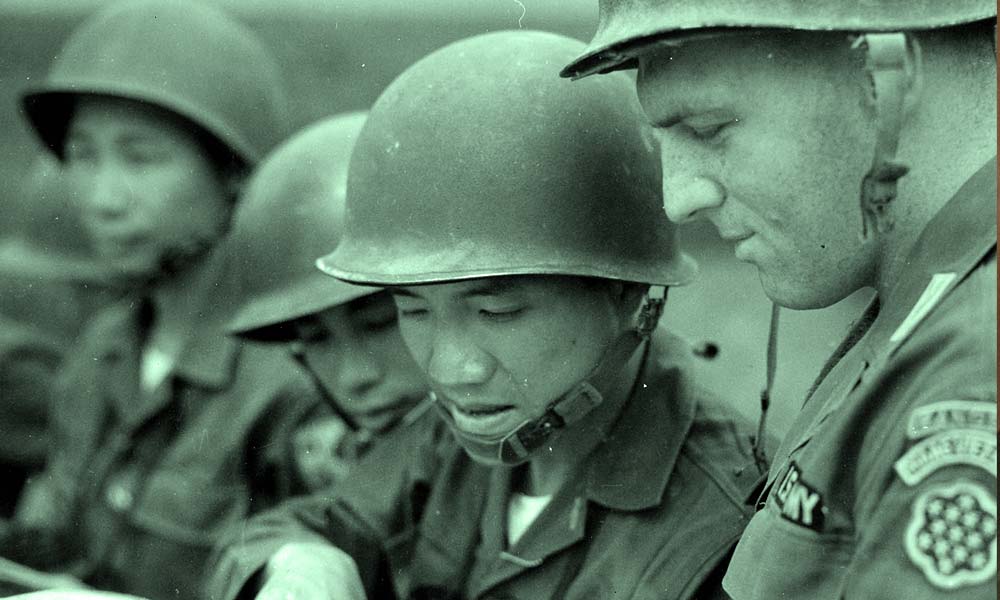
Photo: Soldier from U.S. Army Military Assistance Advisory Group trains troops at the battalion level in Vietnam circa 1955 - 1964
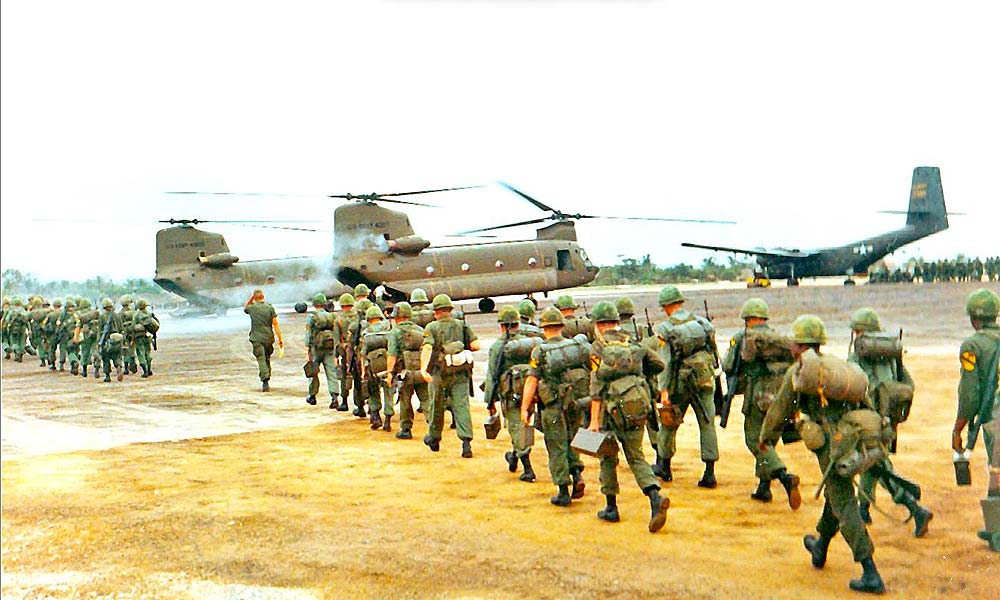
Photo: Soldiers in 1st Cavalry Division prepare to board CH-47's and C-7a's in Vietnam, Sept. 14, 1965. Source: U.S. Army Center for Military History. See Full Historical Slideshow at CMH Website

In the first major engagement of the war between regular U.S. and North Vietnamese forces, Col. Tony Nadal and his fellow 3rd Brigade, 1st Calvary Division (Airmobile) launched the first heliborne assault of its kind against the North Vietnamese forces. This three day battle resulted in the loss of thousands of lives, and tested the limits of both armies capabilities. Source: AARP.
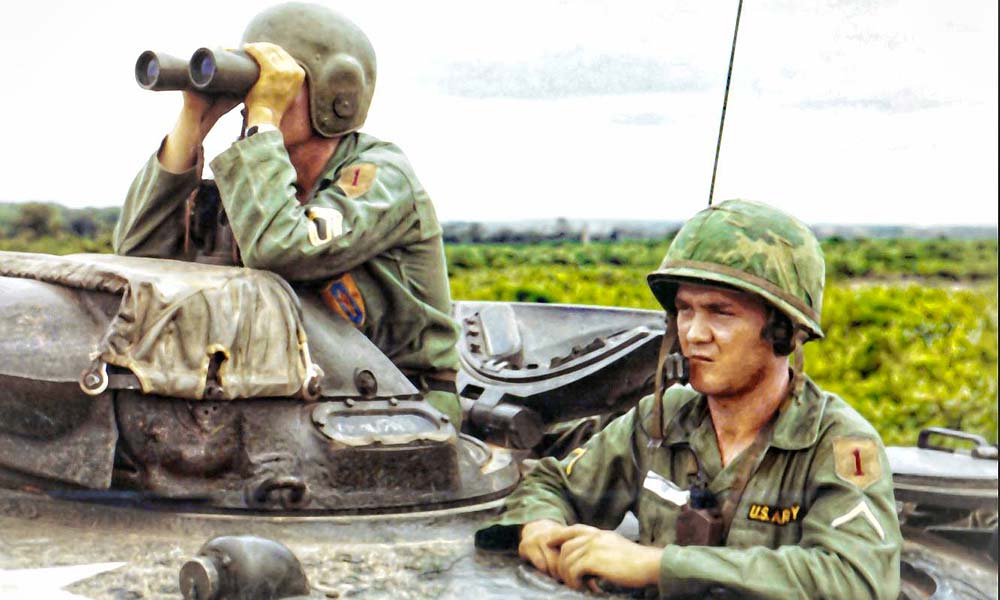
Photo: Soldiers from Troop B, 1st Squadron, 4th Cavalry, 1st Infantry Division survey the landscape north of Saigon from an M-48 Tank, October 20, 1965. Source: U.S. Army Center for Military History. See Full Historical Slideshow at CMH Website
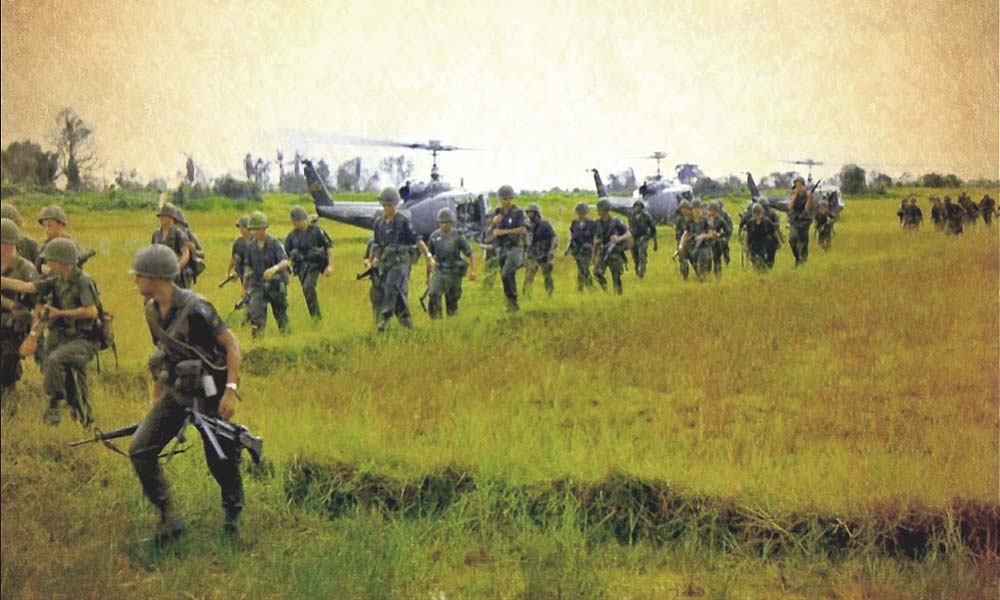
Photo: Members of Company B, 2nd Battalion, 503rd Infantry, 173rd Airborne BDE move out after landing in War Zone D, northeast of Saigon, June 24, 1965. Source: U.S. Army Center for Military History. See Full Historical Slideshow at CMH Website
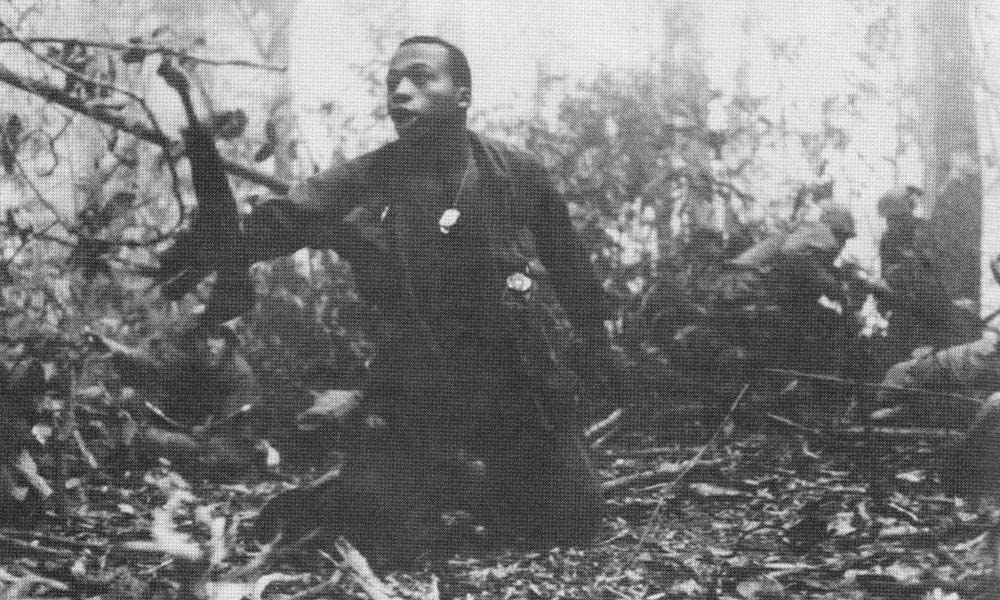
A U.S. Paratrooper calls for a medic as the 1st Battalion, 503rd Infantry battles for Hill 882, southwest of Dak To, November, 1967. From Joel D. Meyerson, Images of a Lengthy War. Washington DC: US Army Center of Military History, 1986. This photo looks like it is of Mahlon S Jenkins, A/1/503d - 173rd Airborne Brigade, and was taken during the battle of Dak To on Hill 882.

The Tet Offensive began in the early hours of January 31, 1968, during the Vietnam War, and consisted of simultaneous attacks by some 85,000 troops under the direction of the North Vietnamese government.The offensive was a crushing tactical defeat for the North, but it struck a sharp psychological blow that eroded support for the war among the American public and political establishment. The offensive derives its name from the Vietnamese New Year holiday, during which the attacks occurred.
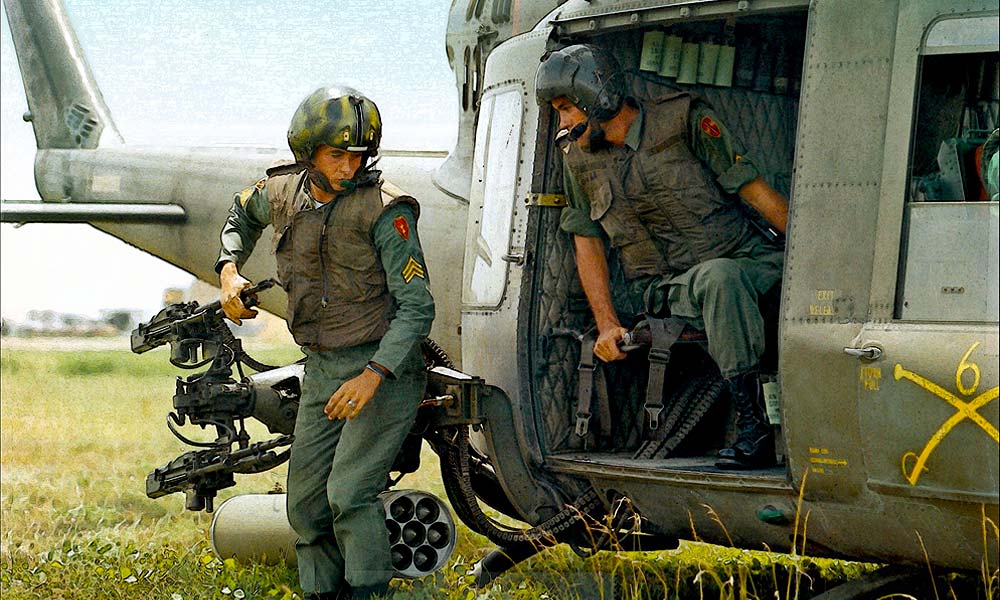
Photo: A crew of a UH-1B Huey Gunship prepare for a mission. September 12, 1965. Source: U.S. Army Center for Military History. See Full Historical Slideshow at CMH Website
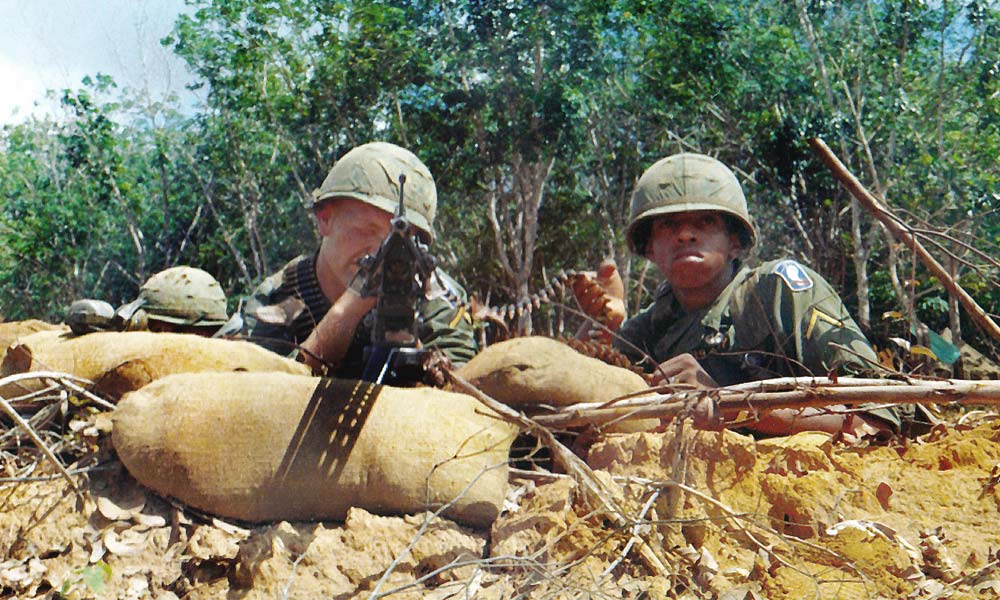
Photo: An M-60 team from 173rd Airborne BDE on the perimeter of Bien Hoa Airbase, June 10, 1965. Source: U.S. Army Center for Military History. See Full Historical Slideshow at CMH Website

The Battle of Hamburger Hill began on May 10, 1969. Occupying a prominent position in the A Shau Valley in South Vietnam, a major supply route for regular North Vietnamese troops, the People's Army of Vietnam or PAVN. The mountain was known locally as "the mountain of the crouching beast." And designated as Hill 937, by the US Army. The men of the 101st airborne who fought there christened it 'hamburger hill'. Source: Pritzker Military Museum & Library
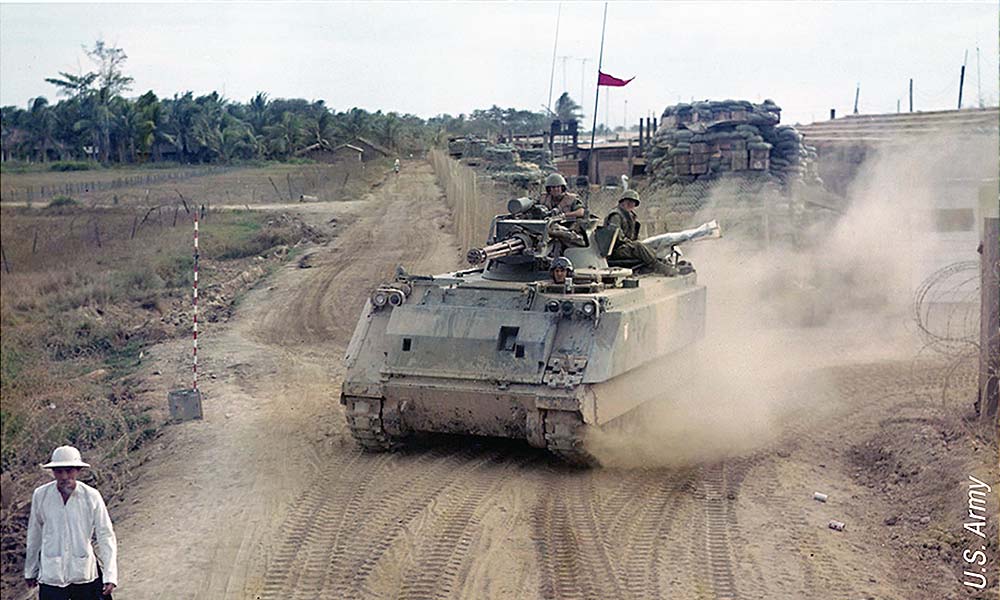
U.S. soldiers operate an armored personnel carrier equipped with a Vulcan antiaircraft gun. American troops used a Vulcan during an enemy ambush on Highway 13 in northern III Corps on 11 January 1969. Source: U.S. Army Center of Military History publication. "Transition, November 1968-December 1969", The U.S. Army Campaigns of the Vietnam War by Adrian G Trass. Vietnam War, 1968, 1969
See full .PDF
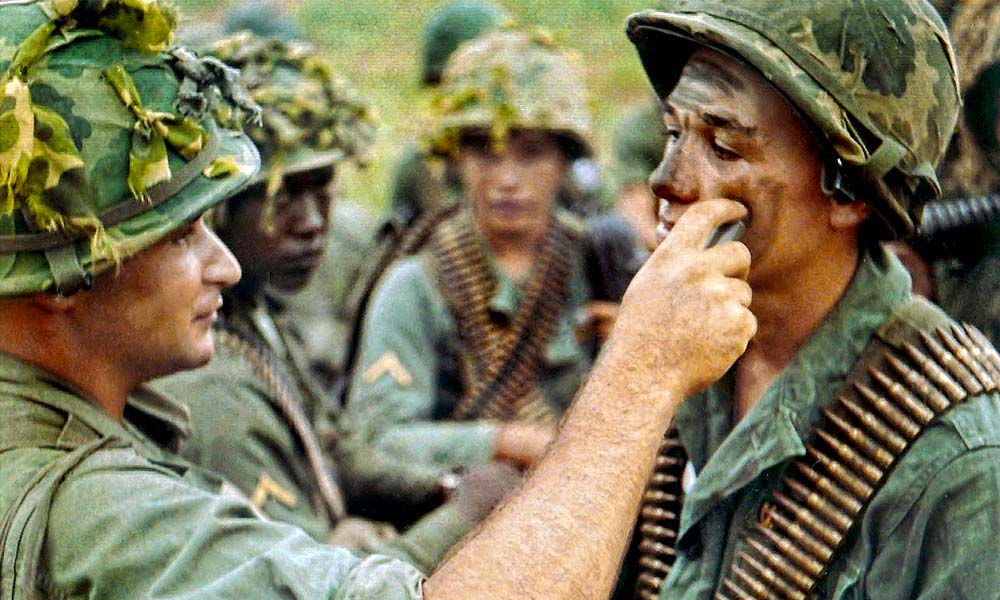
Photo: Members of Company B, 2nd Battalion, 503d, 173rd Airborne Brigade apply blacking prior to a mission in War Zone D, June 24, 1965. Source: U.S. Army Center for Military History. See Full Historical Slideshow at CMH Website
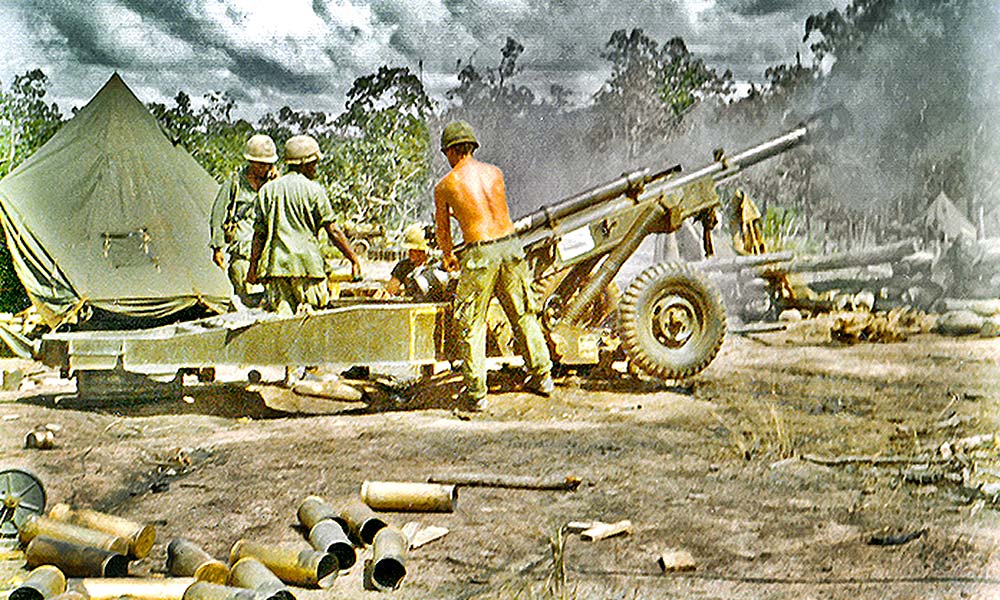
Photo: Men from Battery B, 1st Battalion, 77th Artillery fire from LZ Fatima, August 26th 1966. Source: U.S. Army Center for Military History. See Full Historical Slideshow at CMH Website

Photo: A U.S. Air Force Boeing B-52F-70-BW Stratofortress (s/n 57-0162, nicknamed "Casper The Friendly Ghost") from the 320th Bomb Wing dropping Mk 117 750 lb (340 kg) bombs over Vietnam. This aircraft was the first B-52F used to test conventional bombing in 1964, and later dropped the 50,000th bomb of the "Arc Light" campaign. B-52Fs could carry 51 bombs and served in Vietnam from June 1965 to April 1966 when they were replaced by "Big Belly" B-52Ds which could carry 108 bombs. Source: U.S. Air Force
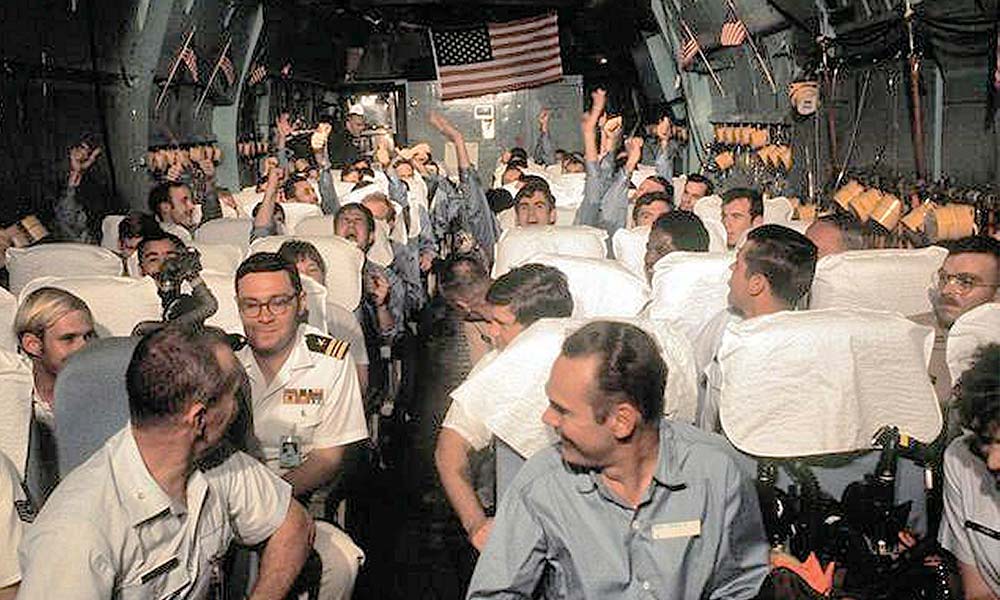
Recently released United States POWs from North Vietnamese prison camps being flown on-board the "Hanoi Taxi" (C-141A 66-0177) from Hanoi, North Vietnam to Clark Air Base, Philippines Source: USAF - United States Air Force Photograph
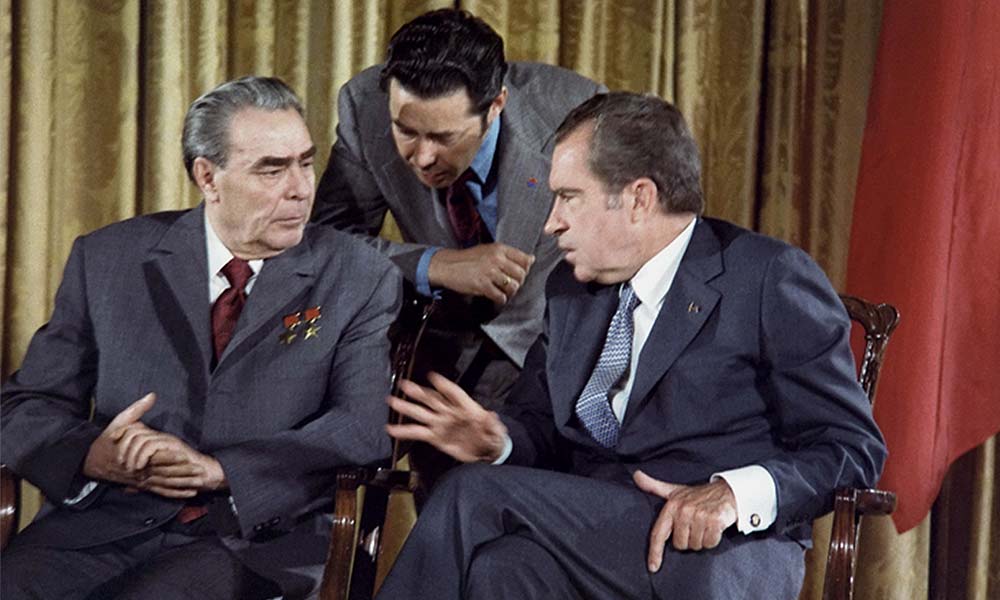
Photo: Richard Nixon (right) meets Leonid Brezhnev (left) June 19, 1973 during the Soviet Leader's U.S. visit. The interpreter is Viktor Sukhodrev. Source: National Archives and Records Administration, cataloged under the National Archives Identifier (NAID) 194517.
U.S. ARMY COMMANDS OF THE VIETNAM WAR
Click on each command patch to learn more about the unit's history to include the time frame and locations where each unit served during the Vietnam War.
-
Military Assistance Advisory Group, Vietnam
1955-1964, Saigon -
1st Cavalry Division (Airmobile)
1965-1972, An Khe, Phuoc Vinh, Bien Hoa
VISIT HOME PAGE -
1st Brigade, 5th Infantry Division (Mechanized)
1968-1971, Dong Ha -
4th Infantry Division
1966-1970, An Khe, Camp Enari (south of Pleiku City)
VISIT HOME PAGE -
11th Infantry Brigade (Light)
1967-1971, Duc Pho -
1st Signal Brigade
1966-1972, Saigon, Long Binh
VISIT HOME PAGE -
101st Airborne Division
1965-1971, Bien Hoa, Phan Rang, Phu Bai
VISIT HOME PAGE -
9th Infantry Division
1966-1969, Bear Cat, Dong Tam -
25th Infantry Division
1966-1971, Cu Chi, Long Binh
VISIT HOME PAGE -
1st Aviation Brigade
1966-1973, Long Binh, Saigon
VISIT HOME PAGE -
5th Special Forces Group (Airborne)
1964-1971, Nha Trang
VISIT HOME PAGE -
1st Logistical Command
1965-1970, Saigon, Long Binh
VISIT HOME PAGE -
3d Brigade, 82d Airborne Division
1968-1969, Phu Bai, Phu Loi
VISIT HOME PAGE -
I Field Force, Vietnam
1966-1971, Nha Trang -
199th Infantry Brigade (Light)
1966-1970, Long Binh, Bien Hoa -
1st Infantry Division
1965-1970, Bien Hoa, Di An, Lai Khe
VISIT HOME PAGE -
23d Division (Americal)
1967-1971, Chu Lai -
II Field Force, Vietnam
1966-1971, Long Binh -
44th Medical Brigade
1966-1970, Saigon, Long Binh
VISIT HOME PAGE -
198th Infantry Brigade (Light)
1967-1971, Duc Pho, Chu Lai
VISIT HOME PAGE -
18th Engineer Brigade
1965-1971, Saigon, Dong Ba Thin -
U.S. Army, Vietnam
1965-1972, Saigon, Long Binh -
Capital Military Assistance Command
1968-1972, Saigon -
173d Airborne Brigade
1965-1971, Bien Hoa, An Khe
VISIT HOME PAGE -
196th Infantry Brigade (Light)
1966-1972, Tay Ninh, Chu Lai, Tam Ky, Danang
VISIT HOME PAGE -
20th Engineer Brigade
1967-1971, Bien Hoa
VISIT HOME PAGE -
18th Military Police Brigade
1966-1973, Long Binh
VISIT HOME PAGE -
XXIV Corps
1968-1972, Phu Bai, Danang

Medal of Honor
The Medal of Honor is the nation's highest medal awarded to members of the armed forces for valor in combat. The medal was first authorized in 1861 for Sailors and Marines and following year for Soldiers as well. Medals of Honor are awarded sparingly and are bestowed only to the bravest of the brave. We encourage you to learn more about the 174 Soldiers who served during Vietnam that received a Medal of Honor for their heroic actions.
Soldier Stories
Below are Soldier Stories of the men and women who exhibited the core Army values of Loyalty, Duty, Respect, Selfless Service, Honor, Integrity, and Personal Courage during the Vietnam War.
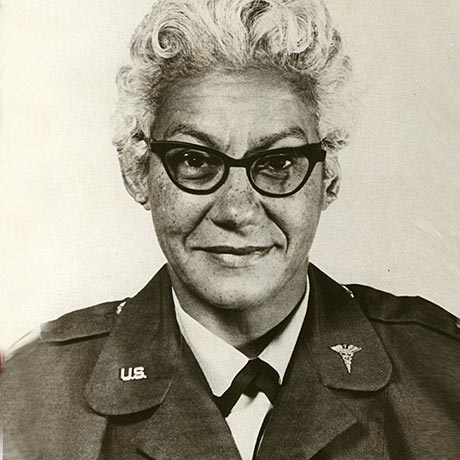
Colonel
Clotilde Dent Bowen
First Black physician to hold a military commission and the first woman commander of a military hospital
READ MOREClotilde Dent Bowen
 First Black physician to hold a military commission and the first woman commander of a military hospital
First Black physician to hold a military commission and the first woman commander of a military hospital
Clotilde (Klow-TILL-da) Dent Bowen was one of many outstanding women who served with distinction. She was the first African American woman to graduate from Ohio State University's School of Medicine, one of the first female doctors in the Army, the first Black physician to hold a military commission, and the first woman commander of a military hospital. In 1970, Colonel Bowen served in Vietnam as the Neuro-Psychiatric Physician for the entire U.S. Army. She was an advocate on issues related to drugs and alcohol and post-traumatic stress disorder and worked to lessen racial conflicts during the Vietnam War. She was awarded the Bronze Star Medal and the American Legion of Merit in 1971, and the Meritorious Service Medal in 1974.
Colonel Clotilde Dent Bowen
First Black physician to hold a military commission and the first woman commander of a military hospital
Clotilde (Klow-TILL-da) Dent Bowen was one of many outstanding women who served with distinction. She was the first African American woman to graduate from Ohio State University's School of Medicine, one of the first female doctors in the Army, the first Black physician to hold a military commission, and the first woman commander of a military hospital. In 1970, Colonel Bowen served in Vietnam as the Neuro-Psychiatric Physician for the entire U.S. Army. She was an advocate on issues related to drugs and alcohol and post-traumatic stress disorder and worked to lessen racial conflicts during the Vietnam War. She was awarded the Bronze Star Medal and the American Legion of Merit in 1971, and the Meritorious Service Medal in 1974.
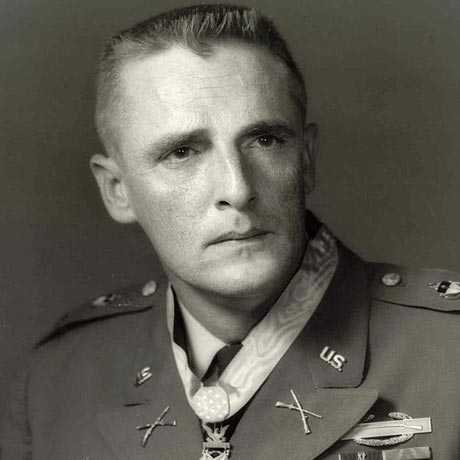
First Lieutenant
Charles Williams
Medal of Honor Recipient
READ MORECharles Williams
 Medal of Honor Recipient
Medal of Honor Recipient
In June 1965, First Lieutenant Charles Williams was serving in Detachment A, 5th Special Forces Group, 1st Special Forces when hostile forces attacked his camp. In a nightmarish fight that lasted 14 hours, he was wounded multiple times but still directed defenses using flares as reference points to air strikes. He inspired his team to hold out against the insurgent forces. As the Vietcong continued to besiege the stronghold, firing a machine gun directly south of the building, Williams and a volunteer took a rocket launcher and worked their way across open terrain. The sight was faulty on the rocket launcher, but they hit the machine gun and took it out of action. Both men were wounded on the way back, but Williams continued to direct the air strikes, and evacuated his team. An inspiration to his men, he was undaunted by the assault.
First Lieutenant Charles Williams
Medal of Honor Recipient
In June 1965, First Lieutenant Charles Williams was serving in Detachment A, 5th Special Forces Group, 1st Special Forces when hostile forces attacked his camp. In a nightmarish fight that lasted 14 hours, he was wounded multiple times but still directed defenses using flares as reference points to air strikes. He inspired his team to hold out against the insurgent forces. As the Vietcong continued to besiege the stronghold, firing a machine gun directly south of the building, Williams and a volunteer took a rocket launcher and worked their way across open terrain. The sight was faulty on the rocket launcher, but they hit the machine gun and took it out of action. Both men were wounded on the way back, but Williams continued to direct the air strikes, and evacuated his team. An inspiration to his men, he was undaunted by the assault.
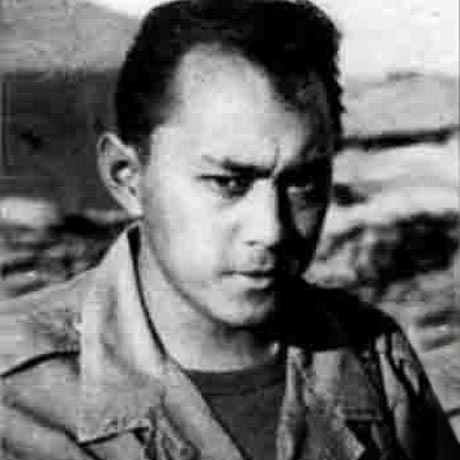
Sergeant First Class
Rodney Yano
Medal of Honor Recipient
READ MORERodney Yano
 Medal of Honor Recipient
Medal of Honor Recipient
Sergeant First Class Rodney Yano (YAH-no) served with the Air Calvery Troop, 11th Armored Cavalry Regiment. In 1969, in dense jungle near Bien Hao (Bin-WHA), he was aboard a command-and-control helicopter when they began receiving intense fire. He fired back and marked their positions with smoke and white phosphorous grenades, so the commander could direct more accurate artillery fire against the enemy. One of those grenades exploded prematurely, covering him with burning phosphorous and detonating the ammunition in the helicopter. The pilot lost control, but Yano began hurling burning ammunition from the helicopter. His bravery cost him his life, but the pilot was able to regain control of the aircraft because of Yano's actions, which helped save the lives of the other crew members.
Sergeant First Class Rodney Yano
Medal of Honor Recipient
Sergeant First Class Rodney Yano (YAH-no) served with the Air Calvery Troop, 11th Armored Cavalry Regiment. In 1969, in dense jungle near Bien Hao (Bin-WHA), he was aboard a command-and-control helicopter when they began receiving intense fire. He fired back and marked their positions with smoke and white phosphorous grenades, so the commander could direct more accurate artillery fire against the enemy. One of those grenades exploded prematurely, covering him with burning phosphorous and detonating the ammunition in the helicopter. The pilot lost control, but Yano began hurling burning ammunition from the helicopter. His bravery cost him his life, but the pilot was able to regain control of the aircraft because of Yano's actions, which helped save the lives of the other crew members.
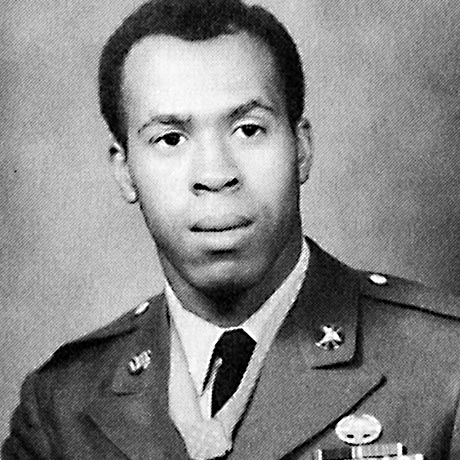
Private First Class
Clarence Eugene Sasser
Medal of Honor Recipient
READ MOREClarence Eugene Sasser
 Medal of Honor Recipient
Medal of Honor Recipient
Before entering the Army, Clarence Eugene Sasser was a chemistry major at the University of Houston. He came from a poor farming family and paying for college was a challenge, so he decided to pick up more work hours and go part-time at school, making him eligible for the draft. At 19 years old, the Army trained him to be a medic. In January of 1968, Private First Class Clarence Eugene Sasser was assigned to Headquarters and Headquarters Company, 3rd Battalion, 60th Infantry Regiment, 9th Infantry Division. On a reconnaissance force operation during an air assault in the Mekong (ME-Kong) Delta, his unit took heavy fire from a well-fortified enemy position. In just 30 minutes, they had 30 casualties. He recalled the attack and said, “We go in, and the helicopter started taking fire. One of the helicopters got hit, and went down. Fire was all around us, with the helicopter down, there wasn't any choice, we had to go in.” Without hesitation, Sasser ran across an open rice paddy through a hail of fire to assist the wounded.
He said, “I learned early on the best way to get around that day was to simply grab the rice and slide yourself along, you can move better like that, and if you stand up you’re dead, especially if they see your bag, they know you're a medic and if they killed a medic, probably a lot of people would die. That was the rationale.” Despite being attacked and wounded, he searched the rice paddy for hours, bringing others to safety and attending to their wounds.
After a harrowing night, they were evacuated early in the morning. Receiving the Medal of Honor was a confirmation to him that he had done a good job. He said, “I don't think what I did was above and beyond. I never have. And I haven't made a point of it, but being one of two Black guys (who were awarded the Medal of Honor) who are alive now, I think it means a lot to the country that I am who I am.”
Private First Class Clarence Eugene Sasser
Medal of Honor Recipient
Before entering the Army, Clarence Eugene Sasser was a chemistry major at the University of Houston. He came from a poor farming family and paying for college was a challenge, so he decided to pick up more work hours and go part-time at school, making him eligible for the draft. At 19 years old, the Army trained him to be a medic. In January of 1968, Private First Class Clarence Eugene Sasser was assigned to Headquarters and Headquarters Company, 3rd Battalion, 60th Infantry Regiment, 9th Infantry Division. On a reconnaissance force operation during an air assault in the Mekong (ME-Kong) Delta, his unit took heavy fire from a well-fortified enemy position. In just 30 minutes, they had 30 casualties. He recalled the attack and said, “We go in, and the helicopter started taking fire. One of the helicopters got hit, and went down. Fire was all around us, with the helicopter down, there wasn't any choice, we had to go in.” Without hesitation, Sasser ran across an open rice paddy through a hail of fire to assist the wounded.
He said, “I learned early on the best way to get around that day was to simply grab the rice and slide yourself along, you can move better like that, and if you stand up you’re dead, especially if they see your bag, they know you're a medic and if they killed a medic, probably a lot of people would die. That was the rationale.” Despite being attacked and wounded, he searched the rice paddy for hours, bringing others to safety and attending to their wounds.
After a harrowing night, they were evacuated early in the morning. Receiving the Medal of Honor was a confirmation to him that he had done a good job. He said, “I don't think what I did was above and beyond. I never have. And I haven't made a point of it, but being one of two Black guys (who were awarded the Medal of Honor) who are alive now, I think it means a lot to the country that I am who I am.”
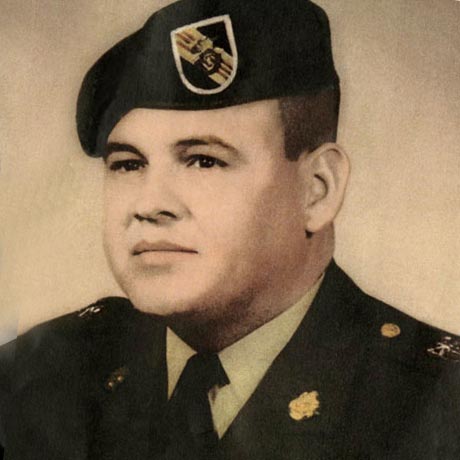
Master Sergeant
Jose Rodela
Medal of Honor Recipient
READ MOREJose Rodela
 Medal of Honor Recipient
Medal of Honor Recipient
Master Sergeant Jose Rodela (Ro-DEL-ah) received the Medal of Honor for valorous actions on September 1, 1969, while serving in Detachment B-36, Company A, 5th Special Forces Group (Airborne), 1st Special Forces. He was a company commander in Phuoc Long (Foo-OCK-long) Province, Vietnam. Rodela commanded his company throughout eighteen hours of continuous attack. Throughout the battle, in spite of his wounds, Rodela repeatedly exposed himself to enemy fire to attend to the fallen and eliminate an enemy rocket position.
Master Sergeant Jose Rodela
Medal of Honor Recipient
Master Sergeant Jose Rodela (Ro-DEL-ah) received the Medal of Honor for valorous actions on September 1, 1969, while serving in Detachment B-36, Company A, 5th Special Forces Group (Airborne), 1st Special Forces. He was a company commander in Phuoc Long (Foo-OCK-long) Province, Vietnam. Rodela commanded his company throughout eighteen hours of continuous attack. Throughout the battle, in spite of his wounds, Rodela repeatedly exposed himself to enemy fire to attend to the fallen and eliminate an enemy rocket position.
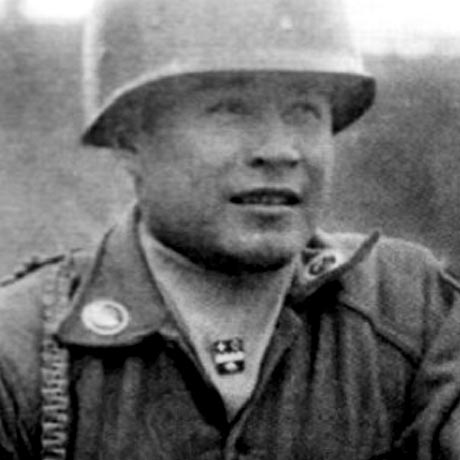
Staff Sergeant Roy Benavidez
Medal of Honor Recipient
In May of 1968, Staff Sergeant Roy Benavidez (Ben-ah-VEE-dez) was assigned to Detachment B56, 5th Special Forces Group (Airborne), 1st Special Forces. He volunteered to help extract a Special Forces Reconnaissance Team, but when he arrived, he realized everyone on the team was either dead or wounded. President Ronald Reagan, who awarded Benavidez (Ben-ah-VEE-dez) the Medal of Honor, remarked that, “If the story of his heroism were a movie script, you would not believe it.” He was severely wounded while saving lives as well as classified materials, and was taken for dead when he arrived back at base camp. He ultimately was awarded the Distinguished Service Cross, four Purple Hearts and the Medal of Honor. His citation noted that “His fearless personal leadership, tenacious devotion to duty and extremely valorous actions in the face of overwhelming odds were in keeping with the highest traditions of the military service, and reflect the utmost credit on him and the United States Army.”
It took almost thirteen years to recognize Benavidez (Ben-ah-VEE-dez), and he was not the only one to be awarded the Medal of Honor many years after his heroic acts. More than a decade ago, Congress directed a review of military records to ensure that leadership had not overlooked or rejected acts of heroism deserving of the Medal of Honor because of prejudice or discrimination.
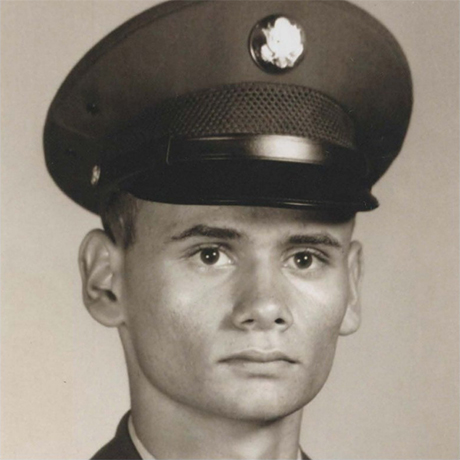
Specialist Five
Dwight Birdwell
Medal of Honor Recipient
READ MOREDwight Birdwell
 Medal of Honor Recipient
Medal of Honor Recipient
On Jan. 31, 1968, a large North Vietnamese element attacked Birdwell’s unit — Troop C, 3rd Squadron, 4th Cavalry, 25th Infantry Division — at Tan Son Nhut Air Base, just outside of Saigon on the first day of what would later become known as the Tet Offensive. Birdwell’s unit bore the brunt of the initial attack, which destroyed many of the unit’s vehicles and incapacitating Birdwell’s tank commander. Under heavy small-arms fire, Birdwell moved his commander to a place of safety and slid into the commander’s hatch.
Armed with the tank’s machine gun and cannon and his M16 rifle, Birdwell fired upon the North Vietnamese. When he exhausted all of his ammunition, Birdwell dismounted and maneuvered to his squadron commander’s helicopter, which had been downed by enemy fire, and retrieved two machine guns and ammunition, with which he and a comrade suppressed the enemy. His machine gun was struck by enemy rounds and exploded, injuring his face and torso.
Birdwell refused evacuation and moved amongst the disabled vehicles and defensive positions, collecting ammunition to distribute to the remaining defenders. While under harassing fire, Birdwell led a small group of defenders past the enemy force and engaged the enemy with hand grenades, disrupting their assault until reinforcements arrived. Birdwell continued to treat wounded until he was ordered to seek medical attention.
Specialist Five Dwight Birdwell
Medal of Honor Recipient
On Jan. 31, 1968, a large North Vietnamese element attacked Birdwell’s unit — Troop C, 3rd Squadron, 4th Cavalry, 25th Infantry Division — at Tan Son Nhut Air Base, just outside of Saigon on the first day of what would later become known as the Tet Offensive. Birdwell’s unit bore the brunt of the initial attack, which destroyed many of the unit’s vehicles and incapacitating Birdwell’s tank commander. Under heavy small-arms fire, Birdwell moved his commander to a place of safety and slid into the commander’s hatch.
Armed with the tank’s machine gun and cannon and his M16 rifle, Birdwell fired upon the North Vietnamese. When he exhausted all of his ammunition, Birdwell dismounted and maneuvered to his squadron commander’s helicopter, which had been downed by enemy fire, and retrieved two machine guns and ammunition, with which he and a comrade suppressed the enemy. His machine gun was struck by enemy rounds and exploded, injuring his face and torso.
Birdwell refused evacuation and moved amongst the disabled vehicles and defensive positions, collecting ammunition to distribute to the remaining defenders. While under harassing fire, Birdwell led a small group of defenders past the enemy force and engaged the enemy with hand grenades, disrupting their assault until reinforcements arrived. Birdwell continued to treat wounded until he was ordered to seek medical attention.
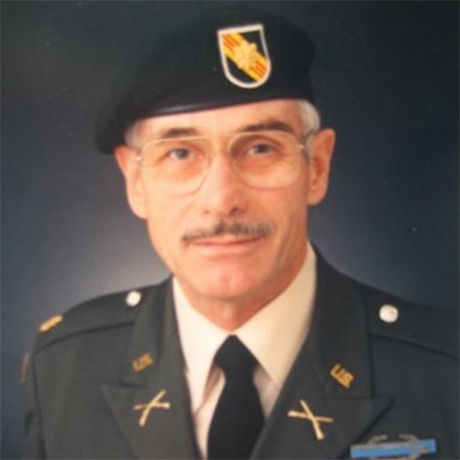
Major
John Duffy
Medal of Honor Recipient
READ MOREJohn Duffy
 Medal of Honor Recipient
Medal of Honor Recipient
During April 14-15, 1972, Duffy, part of Team 162 Military Assistance Command-Vietnam, was senior advisor to the South Vietnamese 11th Airborne Battalion at Fire Support Base Charlie in South Vietnam. In the days before, the enemy had destroyed the battalion command post, and the 11th’s commander had been killed; Duffy himself was twice wounded.
But instead of being evacuated, Duffy led a two-day defense of the surrounded FSB against a battalion-sized enemy force.
During the attack Duffy moved himself close to the enemy, to an exposed position, in order to call in air strikes. Despite being injured again after being struck by fragments from a recoilless rifle round, Duffy stayed and directed U.S. helicopter gunships onto enemy anti-aircraft and artillery positions.
After a severe, 300-artillery-round attack on the base, Duffy personally ensured the wounded troops were moved to safer positions and distributed ammunition to the remaining defenders.
That afternoon, the enemy began a ground assault on the firebase from all sides. Duffy moved from position to position to spot targets for artillery and to adjust fires. The next morning, after the 11th survived an ambush, Duffy led wounded to an evacuation area while in continual pursuit by the enemy.
Related Articles
Major John Duffy
Medal of Honor Recipient
During April 14-15, 1972, Duffy, part of Team 162 Military Assistance Command-Vietnam, was senior advisor to the South Vietnamese 11th Airborne Battalion at Fire Support Base Charlie in South Vietnam. In the days before, the enemy had destroyed the battalion command post, and the 11th’s commander had been killed; Duffy himself was twice wounded.
But instead of being evacuated, Duffy led a two-day defense of the surrounded FSB against a battalion-sized enemy force.
During the attack Duffy moved himself close to the enemy, to an exposed position, in order to call in air strikes. Despite being injured again after being struck by fragments from a recoilless rifle round, Duffy stayed and directed U.S. helicopter gunships onto enemy anti-aircraft and artillery positions.
After a severe, 300-artillery-round attack on the base, Duffy personally ensured the wounded troops were moved to safer positions and distributed ammunition to the remaining defenders.
That afternoon, the enemy began a ground assault on the firebase from all sides. Duffy moved from position to position to spot targets for artillery and to adjust fires. The next morning, after the 11th survived an ambush, Duffy led wounded to an evacuation area while in continual pursuit by the enemy.
Related Articles
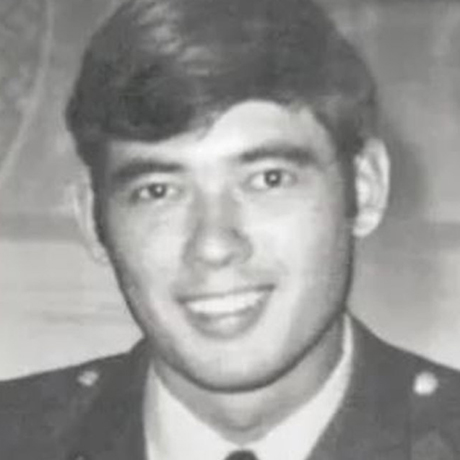
Specialist Five
Dennis Fujii
Medal of Honor Recipient
READ MOREDennis Fujii
 Medal of Honor Recipient
Medal of Honor Recipient
As a crew chief serving with the 237th Medical Detachment, 61st Medical Battalion, 67th Medical Group, Fujii engaged in rescue operations that transported injured South Vietnamese personnel over Laos and the Republic of Vietnam on Feb. 18, 1971. During a second approach to a hot landing zone, the enemy concentrated a barrage of flak at Fujii’s helicopter, causing it to crash in the conflict area, injuring Fujii.
A second helicopter was able to land and load all of his fellow downed airmen. However, Fujii was not able to board because the enemy directed fire on him. Rather than endanger the lives aboard the second helicopter, Fujii waved it off to leave the combat area. Subsequent attempts to rescue him were aborted due to the violent anti-aircraft fire. Fujii secured a radio and informed the aviators in the area that the landing zone was too hot for further evacuation attempts. Fujii remained as the lone American on the ground, treating the injuries of South Vietnam troops throughout the night and the next day.
On the night of Feb. 19, their perimeter came under assault by an enemy regiment and artillery fire. He called U.S. gunships to aid their small force in the battle. For more than 17 hours, Fujii repeatedly exposed himself to hostile fire as he left his entrenchment to observe enemy troop positions and direct air strikes against them. At times the group’s survival was so tentative that Fujii was forced to interrupt radio transmittal in order to place suppressive rifle fire on the enemy while at close quarters.
Though wounded and severely fatigued, Fujii’s actions led to the successful defense of the South Vietnamese troops and their encampment.
Then, after a helicopter was finally able to airlift him from the battle, enemy rounds pierced its hull forcing it to crash-land at a friendly camp, where Fujii would spend another two days before being evacuated.
Specialist Five Dennis Fujii
Medal of Honor Recipient
As a crew chief serving with the 237th Medical Detachment, 61st Medical Battalion, 67th Medical Group, Fujii engaged in rescue operations that transported injured South Vietnamese personnel over Laos and the Republic of Vietnam on Feb. 18, 1971. During a second approach to a hot landing zone, the enemy concentrated a barrage of flak at Fujii’s helicopter, causing it to crash in the conflict area, injuring Fujii.
A second helicopter was able to land and load all of his fellow downed airmen. However, Fujii was not able to board because the enemy directed fire on him. Rather than endanger the lives aboard the second helicopter, Fujii waved it off to leave the combat area. Subsequent attempts to rescue him were aborted due to the violent anti-aircraft fire. Fujii secured a radio and informed the aviators in the area that the landing zone was too hot for further evacuation attempts. Fujii remained as the lone American on the ground, treating the injuries of South Vietnam troops throughout the night and the next day.
On the night of Feb. 19, their perimeter came under assault by an enemy regiment and artillery fire. He called U.S. gunships to aid their small force in the battle. For more than 17 hours, Fujii repeatedly exposed himself to hostile fire as he left his entrenchment to observe enemy troop positions and direct air strikes against them. At times the group’s survival was so tentative that Fujii was forced to interrupt radio transmittal in order to place suppressive rifle fire on the enemy while at close quarters.
Though wounded and severely fatigued, Fujii’s actions led to the successful defense of the South Vietnamese troops and their encampment.
Then, after a helicopter was finally able to airlift him from the battle, enemy rounds pierced its hull forcing it to crash-land at a friendly camp, where Fujii would spend another two days before being evacuated.
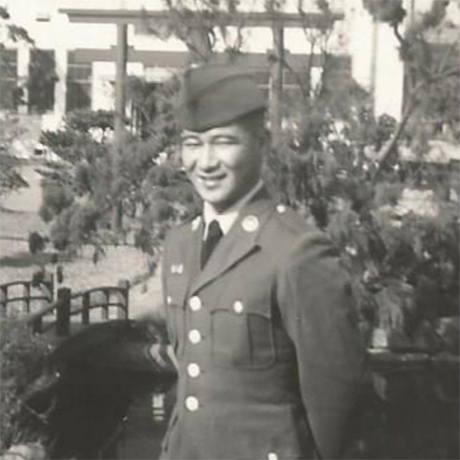
Staff Sergeant
Edward Kaneshiro
Medal of Honor Recipient
READ MOREEdward Kaneshiro
 Medal of Honor Recipient
Medal of Honor Recipient
In a village near Phu Huu 2, a large North Vietnamese contingent ambushed two squads from Kaneshiro’s platoon on Dec. 1, 1966. Kaneshiro, a squad leader with Troop C, First Squadron, 9th Cavalry Regiment, 1st Cavalry Division, was scouting land east of the village at the time of the attack.
Kaneshiro directed his squad toward the sound of the fire, where enemy forces had killed his platoon leader and several other Soldiers, and had his two sister squads pinned down. Kaneshiro swiftly read the situation and realized that the fire from a machine-gun bunker and large concealed trench had to be stopped if anyone were to survive. Kaneshiro deployed his men to cover, then crawled forward, alone, to attack the enemy force.
While flattened to the ground he was somehow able to throw a grenade through the aperture of the bunker, eliminating it as a threat. Next he leapt into the trench and single-handedly worked his way down its entire 35-meter length, destroying one group of enemies with his rifle and two more enemy groups with grenades.
Kaneshiro’s assault allowed the pinned-down squads to survive and prepare their casualties for evacuation. His actions enabled the orderly extrication and reorganization of the platoon.
Kaneshiro would continue his tour in Vietnam until his passing on March 6, 1967, when he died by enemy gunshot wound at the age of 38.
Staff Sergeant Edward Kaneshiro
Medal of Honor Recipient
In a village near Phu Huu 2, a large North Vietnamese contingent ambushed two squads from Kaneshiro’s platoon on Dec. 1, 1966. Kaneshiro, a squad leader with Troop C, First Squadron, 9th Cavalry Regiment, 1st Cavalry Division, was scouting land east of the village at the time of the attack.
Kaneshiro directed his squad toward the sound of the fire, where enemy forces had killed his platoon leader and several other Soldiers, and had his two sister squads pinned down. Kaneshiro swiftly read the situation and realized that the fire from a machine-gun bunker and large concealed trench had to be stopped if anyone were to survive. Kaneshiro deployed his men to cover, then crawled forward, alone, to attack the enemy force.
While flattened to the ground he was somehow able to throw a grenade through the aperture of the bunker, eliminating it as a threat. Next he leapt into the trench and single-handedly worked his way down its entire 35-meter length, destroying one group of enemies with his rifle and two more enemy groups with grenades.
Kaneshiro’s assault allowed the pinned-down squads to survive and prepare their casualties for evacuation. His actions enabled the orderly extrication and reorganization of the platoon.
Kaneshiro would continue his tour in Vietnam until his passing on March 6, 1967, when he died by enemy gunshot wound at the age of 38.
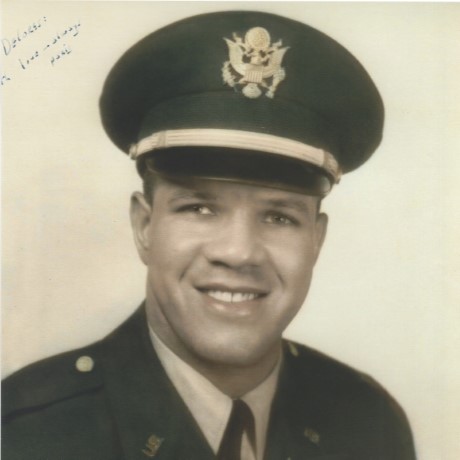
Colonel
Paris Davis
Medal of Honor Recipient
READ MOREParis Davis
 Medal of Honor Recipient
Medal of Honor Recipient
In Bình Định province, Davis and his men were tasked with training a force of local volunteers. On June 18, 1965, he commanded a team of inexperienced South Vietnamese, along with Special Forces Soldiers, against a superior enemy force.
Over the course of two days, Davis selflessly led a charge to neutralize enemy emplacements, called for precision artillery fire, engaged in hand-to-hand combat with the enemy, and prevented the capture of three American soldiers (Robert Brown, John Reinberg, and Billy Waugh) while saving their lives with a medical extraction. Davis sustained multiple gunshot and grenade fragment wounds during the 19-hour battle and refused to leave the battlefield until his men were safely removed.
For these heroic acts during his second tour in Vietnam, Davis received the Silver Star, the Bronze Star Medal with “V” device, a Purple Heart with one Bronze Oak Leaf Cluster, and the Air Medal with “V” device. He was also awarded the Soldier's Medal for heroism, when he saved the life of a Soldier, a driver who was stuck in an overturned and burning fuel truck. Davis pulled the Soldier from the truck just before it exploded. Davis is one of only four service members in U.S. military history to receive both the Soldier's Medal and the Medal of Honor.
Colonel Paris Davis
Medal of Honor Recipient
In Bình Định province, Davis and his men were tasked with training a force of local volunteers. On June 18, 1965, he commanded a team of inexperienced South Vietnamese, along with Special Forces Soldiers, against a superior enemy force.
Over the course of two days, Davis selflessly led a charge to neutralize enemy emplacements, called for precision artillery fire, engaged in hand-to-hand combat with the enemy, and prevented the capture of three American soldiers (Robert Brown, John Reinberg, and Billy Waugh) while saving their lives with a medical extraction. Davis sustained multiple gunshot and grenade fragment wounds during the 19-hour battle and refused to leave the battlefield until his men were safely removed.
For these heroic acts during his second tour in Vietnam, Davis received the Silver Star, the Bronze Star Medal with “V” device, a Purple Heart with one Bronze Oak Leaf Cluster, and the Air Medal with “V” device. He was also awarded the Soldier's Medal for heroism, when he saved the life of a Soldier, a driver who was stuck in an overturned and burning fuel truck. Davis pulled the Soldier from the truck just before it exploded. Davis is one of only four service members in U.S. military history to receive both the Soldier's Medal and the Medal of Honor.
U.S. ARMY VIETNAM WAR MUSEUMS & EXHIBITS
- The National Museum of the U.S. Army, Fort Belvoir, VA
- Yuma Proving Ground Heritage Center, Yuma, AZ
- Lewis Army Museum, JBLM, WA
- Museum of Hawaii, Fort DeRussey, HI
- Transportation Museum, Fort Eustis, VA
- Army Women's Museum, Fort Lee, VA
- Quartermaster Museum, Fort Lee, VA
- West Point Museum, West Point, NY
- 82nd Airborne Museum, Fort Bragg, NC
- Airborne & Special Operations Museum, Fort Bragg, NC
- U.S. Army Artillery Museum, Fort Sill, OK
- Air Defense Artillery Training Support Facility, Fort Sill, OK
- National Infantry Museum, Fort Benning, GA
- Aviation Museum, Fort Rucker, AL
- MP Museum, Fort Leonard Wood, MO
- Engineer Museum, Fort Leonard Wood, MO
- Armor Training Support Facility (TSF), Fort Benning, GA
- Chemical Museum, Fort Leonard Wood, MO
- Don F. Pratt Museum (101st ABN), Fort Campbell, KY
- Ft Jackson Museums (Chaplain Corps, AG Corps, Finance Corps & Army Basic Training Museum), SC
- General George Patton Museum, Fort Knox, KY
- 1st Infantry Division Museum, Fort Riley, KS
- 4th Infantry Division Museum, Fort Carson, CO
- 1st Cavalry Division Museum, Fort Hood, TX
- U.S. Army Medical Department Museum, Fort Sam Houston, TX
- Noncommissioned Officer Heritage and Education Center, Fort Bliss, TX